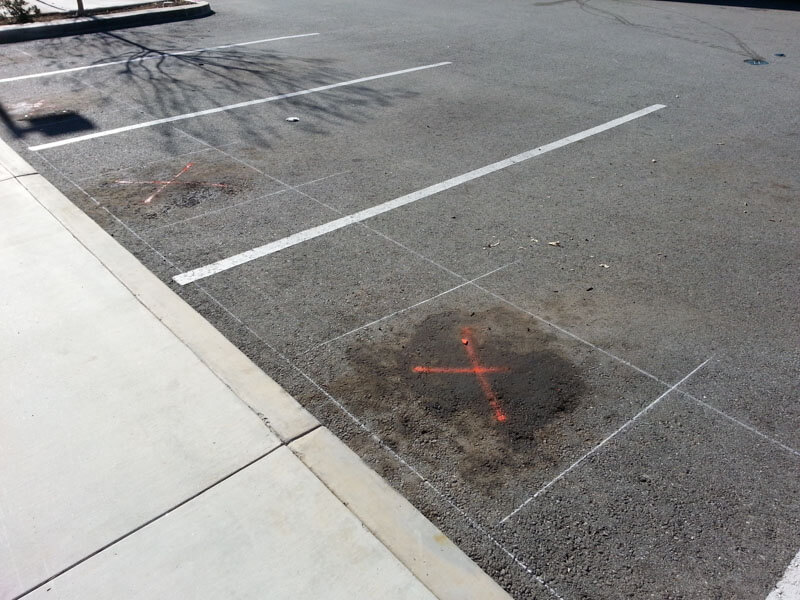Dealing with the 3 Stages of Oil Spots on Asphalt
Posted on November 14, 2019 by Rafael CantilloAsphalt has earned a place among the most trusted of paving materials — and for good reason. Not only is asphalt aesthetically pleasing, but it is also durable and long lasting. Of course, to maximize the lifespan of an asphalt surface, you must be proactive about maintenance and repairs. Even relatively minor problems can lead to serious damage if not attended to quickly.

One of the most common causes of asphalt degradation are oil spots left behind on the pavement by automobiles. Oil presents much more than a visual nuisance and over time can seriously undermine the stability of asphalt. Therefore, the sooner you address such oil stains, the better. This article takes a look at the three stages of oil damage, and what you can do to repair each one.
Stage One Oil Spots
Oil poses a serious threat to asphalt because of the way it interacts with the asphalt binder that holds together the crushed aggregate in the pavement. Asphalt binder and motor oil are both products of the petroleum-refining process. In other words, they have a lot in common on a chemical level. Asphalt binder actually contains a certain proportion of petroleum oils itself.
As excess motor oil seeps into the pavement, it alters the chemistry of the asphalt binder, making it softer and more prone to damage than it should be. Fortunately, this process only happens gradually — generally between six and twelve months after oil exposure. Up until then, the oil has not yet penetrated below the surface of the asphalt.
At this stage, the oil has done nothing more than stain the pavement, and can usually be removed through surface cleaning. Numerous alternative methods exist from removing an oil stain, including using kitty litter, baking soda, or even a can of cola. That said, the best approach is to scrub the stain with a mixture of detergent and water, and then follow up by thoroughly rinsing the area.
Older asphalt pavements actually have a degree of protection against oil, since oxidation at the surface level makes it harder for the oil to access the vulnerable asphalt binder. Likewise, pavements that have received regular applications of sealcoat slow down the penetration of oil stains. Relatively new asphalt that has not yet been sealcoated tends to be the most vulnerable to the destructive effects of oil.
That said, owners of asphalt surfaces should understand that, while sealcoating can certainly help to minimize the risks of oil exposure, sealcoating is not in itself a cure for oil stains. In fact, oil spots may actually prevent the sealcoat from bonding with the asphalt binder. An experienced professional ensures optimal adherence by applying oil primers to any stains prior to sealcoating.
Stage Two Oil Spots
Stage two oil spots have moved beyond the surface of the asphalt and begun to alter the chemistry of the asphalt binder. You may notice that the asphalt in such areas appears unusually soft. You may even be able to scoop it away using your finger or the tip of a screwdriver.
Likewise, stage two oil spots often show signs of damage. Because the binder is weakened, it becomes easier for car tires and other sources of abrasion to strip away pieces of aggregate. Paving professionals refer to this kind of surface aggregate loss as raveling. If not attended to quickly, raveling will soon give way to even more serious pitting and potholing.
Raveling is also problematic because it allows water to begin pooling up on the pavement. As water runs over the surface of the asphalt and into damaged areas, it also carries additional oil and/or chemicals with it — substances that further hasten degradation in that area.
At this stage, the solution to the problem involves removing any oil, and then patching the damaged area. Contractors often use a torch or heat lance to quickly burn away any excess oil. At that point, the solution depends on how severe the damage is. Relatively minor areas of surface loss can often be repaired through the application of a chip seal.
The chip seal repair process is nearly identical to the application of sealcoat, except that after the sealcoat has been applied, a layer of crushed gravel is spread across the asphalt and compacted into the surface. This effectively fills in any small areas of loss. More serious raveling, by contrast, may require the use of more substantial asphalt patching compounds.
Stage Three Oil Spots
Stage three oil spots involve deeper and/or more extensive portions of damage to the asphalt. At this point, the asphalt patching compounds used for stage two spots will no longer suffice. Instead, a contractor has two options, depending on the depth and severity of the damage.
Less severe damage can often be repaired by removing one or two inches of asphalt from the surface using a tool known as a planer grinder, or milling machine. With the damaged portion removed, the contractor cleans the exposed asphalt, lays down a tack coat to improve adherence, and then resurfaces the area using fresh hot mix asphalt.
The second, more labor intensive, approach involves saw cutting the damaged area and then applying brand new asphalt. In this method, the entire section of asphalt is removed, thus ensuring that any traces of the oil spot are completely eliminated. Of course, this method is also more labor intensive and expensive than simply milling the surface.
Bottom Line
Oil spots are an unsightly asphalt problem that will only grow worse if you don't attend to them quickly. While it may be tempting to write off the long-term significant of oil spots, you put yourself and your pavement at risk by doing so. Not only do oil spots lead to property damage, but by softening the asphalt they increase the risk of pavement failure.
If located in high-traffic portions of an asphalt surface, oil spots can thus represent a significant liability, since they may lead to accidents and vehicular damage. To learn more about how a professional deals with oil spots, as well as what they can do to keep them at bay, please contact the paving industry experts at Empire Parking Lot Services. Please check out our "Anatomy of a Parking Lot" blog for a more in-depth view of what makes up a parking lot.




Comments